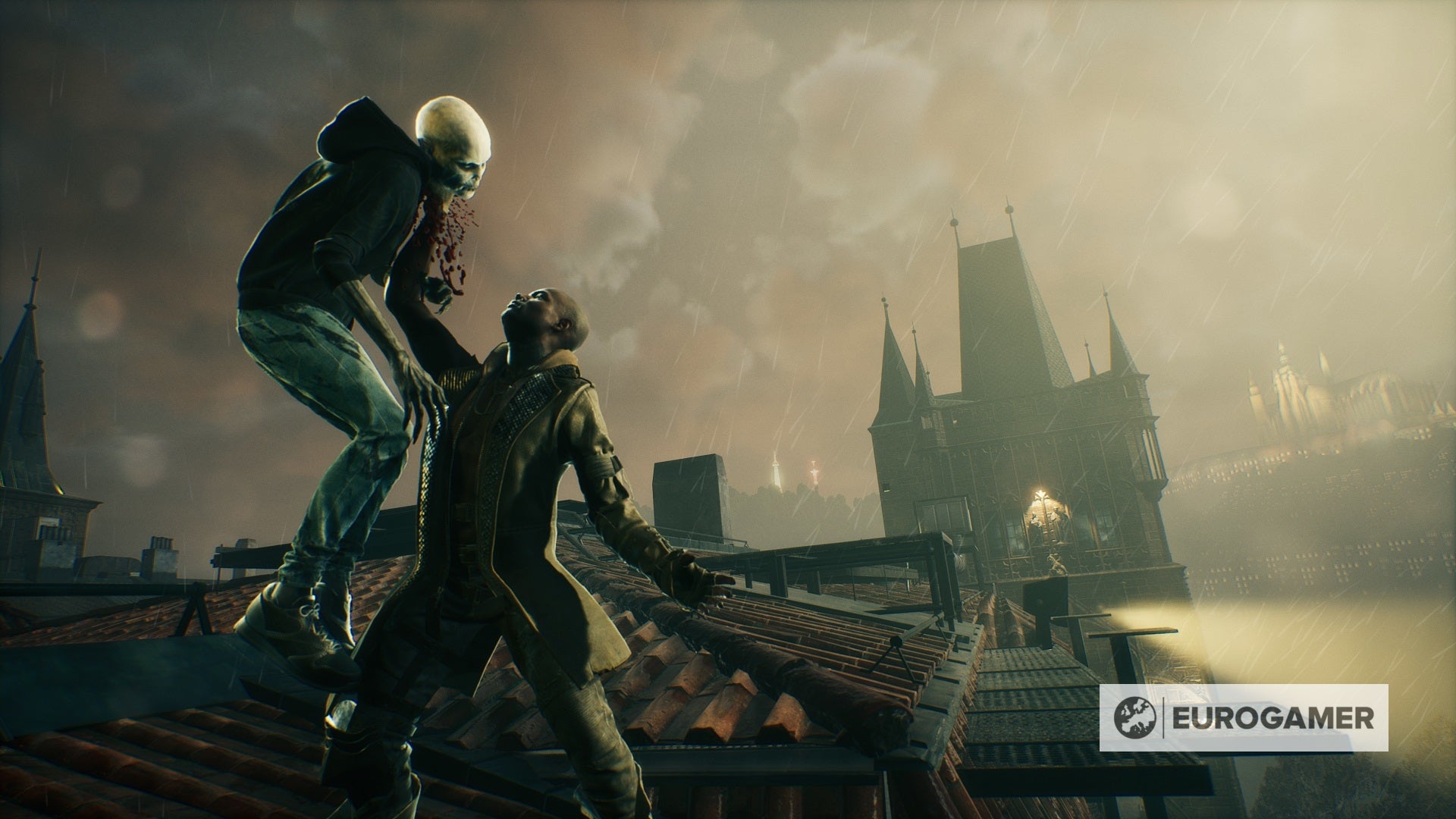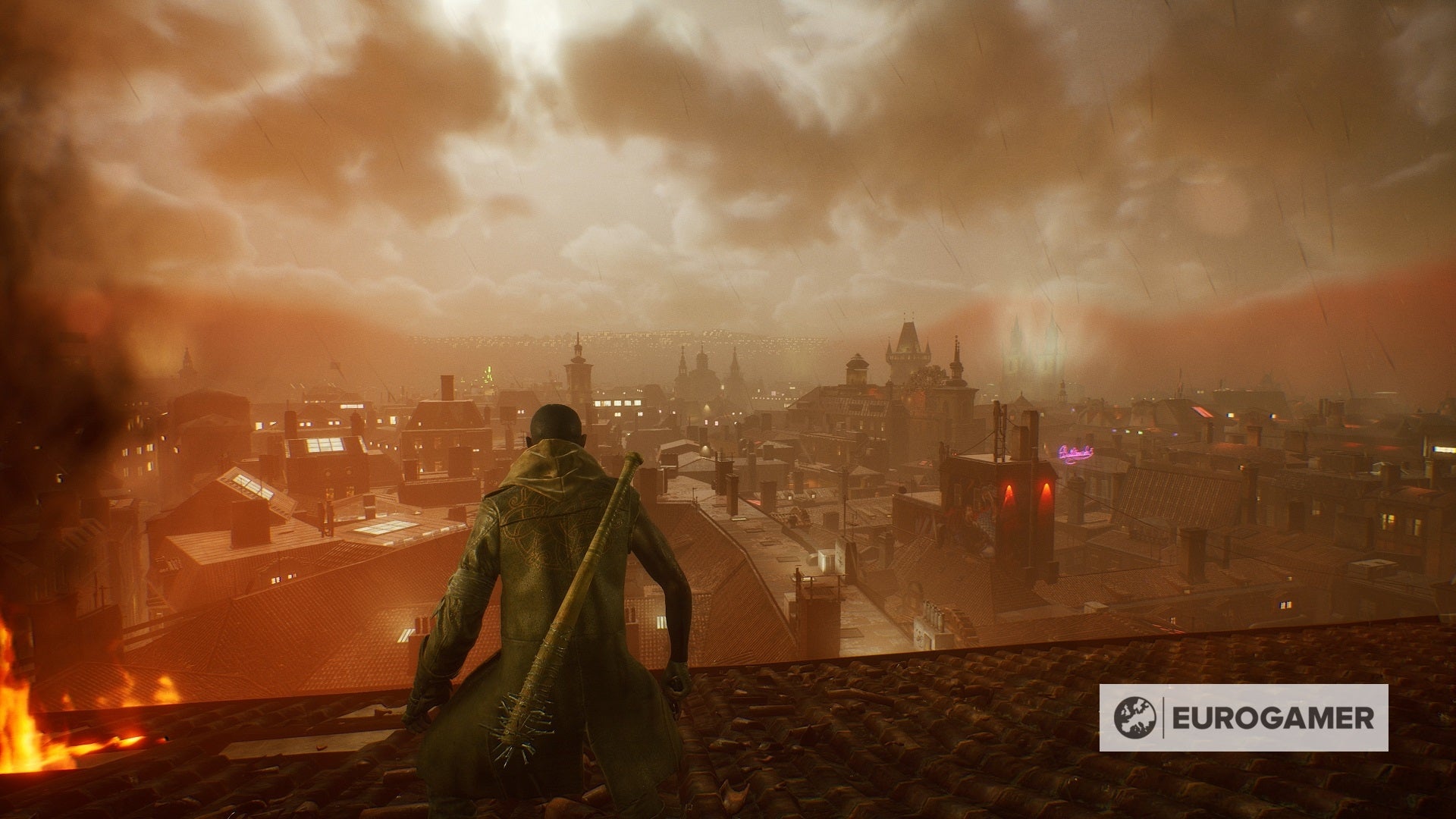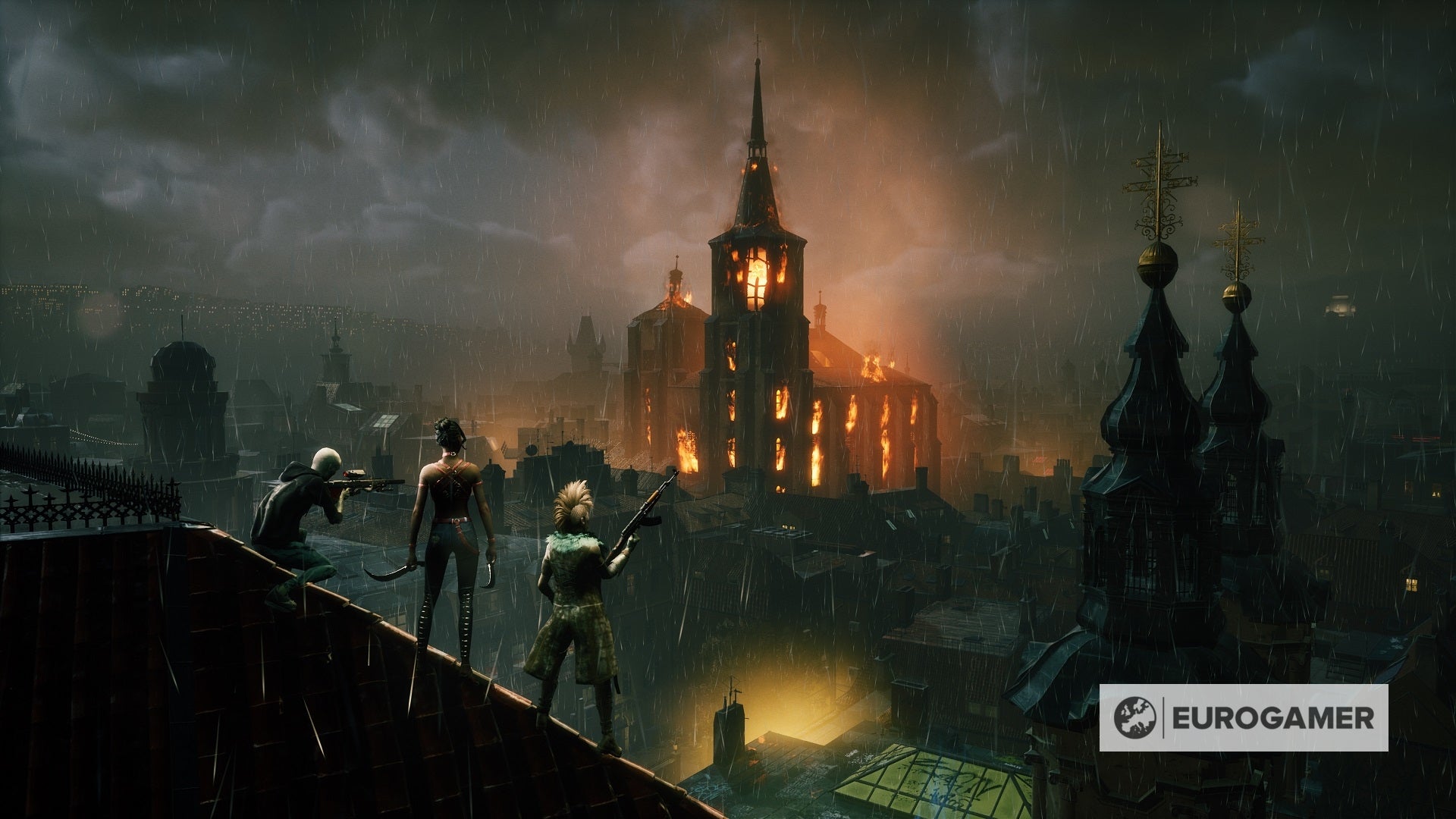The game goes like this (and ’this’ will be quickly familiar to anyone who’s played a battle royale game, which at this point is probably everyone?): you queue solo, or in teams of three, for a big fight in the locked-down city of Prague at night. Exactly how many players can fight together isn’t finalised yet. The current rough-count is 45. You start with no weaponry, so you need to loot it, as well as collect armour and blood packs (health refills), pulling them from the back of police vans, or chests and containers, and sometimes shops, that you find around the city. And the playing area in Prague gradually shrinks as a red mist rolls in. The difference in Bloodhunt comes from your being a vampire. Being a vampire enables you to scrabble up the side of any building simply by holding the spacebar, and to slide along rooftops and leap from them, as well as use your senses to scan the area around you for things of interest. Things like loot, or the whereabouts of a noise (like gunfire), or civilians (I’ll come back to them). Each type of vampire also has special powers. There are three for each character. The first power usually entails a huge boost to movement, be it from a giant leap, an invisible dash, or a kind of spectral teleport; the middle power is passive, which can be something like a health-regen or a partial-vanish while crouching, but there are more; and the third power is an active ability, which varies from damage to support. There are things like ground-pounds, traps, bats that scan the area, heals, and bullet shields. They’re satisfying to use and, because there are only three powers per vampire, plus the scan scan, they’re all relatively easy to get to grips with and understand. There are six characters at the moment, split into three Vampire: The Masquerade clans. There’s the Brujah clan, and it’s fightery Brute and Vandal characters; there’s the Nosferatu clan, and it’s sneaky Saboteur and Prowler characters; and there’s the Toreador clan, and its magic-like Siren and Muse characters. And there are plans for more later on. Civilians: I said I’d come back to them. They lurk on the street below and you can, of course, sink your fangs into them and feed on them. Doing so not only replenishes your health, it bestows a game-long upgrade on you. What you get depends on the kind of civilian you drink from. One might offer a 10 percent cooldown reduction on your powers, another might give you a 10 percent boost in melee damage. You have room for three upgrades but you can unlock more (more ‘resonance slots’) by either feeding on downed players, in a ‘press F to execute’ move known as diablerising, or by feeding on special NPCs from the vampire-hunting Entity faction. These look like heavily armoured soldiers and guard fancy loot, and they’re hard to take down. It’s risk-reward, but if you can unlock all seven possible resonance slots: whew! That’s a significant upgrade. Civilians potentially pose a problem, too. If they see you for too long, or see you do murderous vampire things, they will see you for who you are and break your eponymous Masquerade, which is obviously a bad thing. Bloodhunt realises this by giving you a bloodhunt debuff, which reveals you to all other players for one minute. You do not want that in a game like this. These vampire ideas - this vampire layer - goes a long way to making Bloodhunt feel different to other battle royales. The movement is particularly fun. When you couple it with the tighter layout of the city, and the height of it, and your ability to run along either the streets or the rooftops (and anything in between), it provides you with many ways to close the gap on faraway enemies. This does a lot to stop people camping and sniping. Despite this, Bloodhunt still seems to be a predominantly shooty game. There are some melee weapons, but there are far more guns, and in every encounter I was a part of, it was guns being used. Guns blindsiding me from another rooftop, or from many rooftops around me, and me being downed in seconds, my health disappearing in numbers out of my head. You can get a team respawn, but you need a team-mate to escape and activate it. It’s not really my idea of a vampire fantasy, to be honest, ducking behind chimneys and picking people off with assault rifles. To me, this is far more battle royale than Vampire: The Masquerade. Then again, I only played a few games and was scrambling to keep up, so I didn’t appreciate much of the nuance outlined above. But the pace of a team multiplayer game (I didn’t play solo) also means Bloodhunt struggles to really settle you into a Vampire: The Masquerade world. The city is Prague but it could be anywhere for all the time you have to really appreciate it. It doesn’t help that it’s dark as well. It really doesn’t. Being dark means it’s hard to make out what’s going on, and who’s shooting you. There’s none of the bright clarity that sunlight affords Fortnite or Apex Legends or PUBG. But what can you do? This is a game about vampires. You can hardly turn the sunlight on. While Prague is the main map, and will evolve over time as in other battle royale games, there is another place you can explore. It’s only small though. It’s the lobby area of Elysium, a kind of chapel or church interior where you can run around emoting at people while you wait for the matchmaker to find you a game. It’s nicely detailed, though, and there are some NPCs you can speak to. They give you quests which earn you experience for a battle pass that’s not implemented yet, but will be, I’m assured. It leaves me in two minds about Bloodhunt. It feels a bit thin as it is. There are nice ideas, and it looks smart, but I don’t think it’s enough to pull people from the heavyweight battle royales and keep them occupied for more than a weekend. Nevertheless, this is pre-alpha, and it’s a solid showing. It’s certainly worth keeping an eye on.





